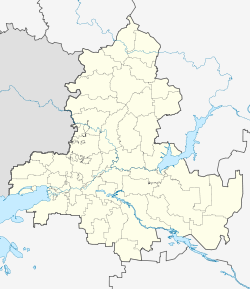Novoshakhtinsk
| city
Novoshakhtinsk
Новошахтинск
|
||||||||||||||||||||||||||||||||||||||||
|
||||||||||||||||||||||||||||||||||||||||
|
||||||||||||||||||||||||||||||||||||||||
| List of cities in Russia | ||||||||||||||||||||||||||||||||||||||||
Novoschachtinsk ( Russian: Новоша́хтинск ) is a Russian city in the Rostov Oblast with 111,075 inhabitants (as of October 14, 2010). It is located around 80 km north of the metropolis of Rostov-on-Don , in the western part of the Rostov Oblast near the Russian border with Ukraine . The closest town is Krasny Sulin ; this is 17 km northeast of Novoschachtinsk.
history
The city came into being in the course of coal mining in this area, which is part of the Donets Basin . Originally a mining workers' settlement founded at the beginning of the 20th century was located here near a mine that belonged to the Rostov industrialist Nikolai Paramonov before the October Revolution . After 1917, the mines were nationalized and the workers' settlement was named Comintern (Russian Коминте́рн , after the Communist International ).
In 1939, when the Comintern settlement was merged with another workers' settlement, the city of Novoschachtinsk was formed, the name of which literally means "New Mining City". In the same year Novoshakhtinsk received city rights. Since its inception and until the end of the Soviet Union, Novoshakhtinsk was geared towards mining coal, which has shaped the cityscape to this day.
Thousands of German prisoners of war from World War II were also employed in the coal mines of Novoschachtinsk . Until the 1950s, these were a large part of the buddies .
The city gained international fame through a serious mining accident in October 2003. At that time, 46 miners were buried in a flood. After six days you could still salvage 12 buddies alive. This “luck in misfortune” was also referred to in the German media as the “miracle of Novoschachtinsk”, based on the German Lengede mine disaster in 1963.
In 2004 the urban-type Sokolowo-Kundryuchinsky settlement (2002: 9600 inhabitants) was incorporated.
Population development
| year | Residents |
|---|---|
| 1939 | 48,035 |
| 1959 | 103,566 |
| 1970 | 101,500 |
| 1979 | 104,152 |
| 1989 | 107,772 |
| 2002 | 101.131 |
| 2010 | 111.075 |
Note: census data
Economy and Transport
During the economic decline in the former Soviet Union in the 1990s, coal production in Novoshakhtinsk came to an almost complete standstill. Today, instead of mining, the light and food industries are two of the city's main industries. An oil refinery as a major employer was opened in 2009.
The city is located near the intersection of highways M4 and M19 , the latter leads to the Ukraine and there as highway M 03 is known. There is a train station just outside the city.
Colleges
- Branch of the South Russian State Technical University
Famous pepole
- Andrei Tschikatilo (1936–1994), serial killer; lived in Novoschachtinsk from 1971 until the end of the 1970s and worked there as a teacher
Individual evidence
- ↑ a b Itogi Vserossijskoj perepisi naselenija 2010 goda. Tom 1. Čislennostʹ i razmeščenie naselenija (Results of the All-Russian Census 2010. Volume 1. Number and distribution of the population). Tables 5 , pp. 12-209; 11 , pp. 312–979 (download from the website of the Federal Service for State Statistics of the Russian Federation)
Web links
- Novoschachtinsk on mojgorod.ru (Russian)


